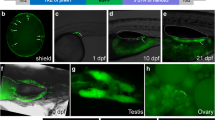Summary
The genesis of the tailless spermatozoa of the tick Ornithodorus moubata has been studied by light and electron microscopy.
In the germ zone of the testis the smallest cells of the spermatogenesis are located, the spermatogonia A which are separated from each other by somatic cells. The result of a multiplication phase with 4 mitoses are clusters of 16 spermatogonia B. While growing up the spermatogonia B differentiate into spermatocytes I. They show a special structure of their border which, after the quickly passed maturation divisions, gets more developed in the spermatides and turns into a vacuole with ribbon-like cytoplasmic processes hanging into it. Simultaneously with an elongation of the spermatide the subsequent apex invaginates into the vacuole and induces an inversion of the spermatide like the finger of a glove. This last step takes place only after the copulation in the female. Then the processes previously hanging into the vacuole are lying as groins close to the outside of the mature spermatozoon. The condensation of the nucleus and the formation of the acrosome are described in particular. Because of the complicated transformation of the spermatide also the nucleus, the acrosome and the centrioles undergo extensive migrations being accomplished in the female.
Zusammenfassung
Die Genese der schwanzlosen Spermatozoen der Zecke Ornithodorus moubata wurde licht- und elektronenmikroskopisch untersucht.
In der Keimzone des Hodens finden sich die kleinsten Zellen der Spermatogenese, die Spermatogonien A, die einzeln durch somatische Zellen voneinander isoliert sind. In einer Vermehrungsphase von 4 Teilungen entstehen Ballen von je 16 Spermatogonien B. Durch Wachstum gehen die Spermatogonien B in Spermatozyten I. Ordnung über. Dabei entsteht in ihnen eine Randstruktur, die sich nach den rasch ablaufenden Reifeteilungen in den Spermatiden zu einer Vakuole entwickelt, in die bandartige Zellfortsätze hineinhängen. Gleichzeitig mit einer Längsstreckung der Spermatide stülpt sich die spätere Spitze in die Vakuole ein und führt zu einer handschuhfingerartigen Umkrempung der Spermatide. Dieser letzte Schritt erfolgt erst nach der Kopulation im Weibchen. Dann liegen die ursprünglich in die Vakuole hängenden Fortsätze dem reifen Spermatozoon außen als Leisten an.
Die Kernkondensation und die Akrosombildung werden im einzelnen beschrieben. Durch die komplizierte Umgestaltung der Spermatide erfahren auch Kern und Akrosom sowie die Zentriolen unfangreiche Ortsveränderungen, die erst im Weibchen abgeschlossen werden.
Similar content being viewed by others
Literatur
Blanchard, R.E., Lewin, R.A., Philpott, D.E.: Fine structure of sperm tails of isopods. Crustaceana 2, 16–20 (1961).
Breucker, H., Horstmann, E.: Die Spermatozoen der Zecke Ornithodorus moubata (Murr). Z. Zellforsch. 88, 1–22 (1968).
Casteel, D.B.: Cytoplasmic inclusions in male germ cells of the fowl tick, Argas miniatus, and histogenesis of the spermatozoon. J. Morph. 28, 643–683 (1917).
Foor, W.E.: Spermatozoan morphology and zygote formation in nematodes. Biology of Reproduction, Suppl. 2, 177–202 (1970).
Gall, J.G.: Centriole replication. A study of spermatogenesis in the snail Viviparus. J. biophys. biochem. Cytol. 10, 163–193 (1961).
Heberer, G.: Die Idiomerie in den Furchungsmitosen von Cyclops viridis Jurine. Z. mikr.-anat. Forsch. 10, 169–206 (1927).
Horstmann, E.: Structures of caryoplasm during the differentiation of spermatids. In: Morphological aspects of andrology, ed. by A.F. Holstein, E. Horstmann. Berlin: Grosse 1970.
—, Breucker, H.: Spermatozoen und Spermiohistogenese von Graphidostreptus spec. (Myriapoda, Diplopoda). I. Die reifen Spermatozoen. Z. Zellforsch. 96, 505–520 (1969).
—: Spermatozoen und Spermiohistogenese von Spirostreptus spec. (Myriapoda, Diplopoda). II. Die Spermiohistogenese. Z. Zellforsch. 99, 153–184 (1969).
Ito, S., Winchester, R. J.: The fine structure of the gastric mucosa in the bat. J. Cell Biol. 16, 541–578 (1963).
Kaestner, A.: Arthropoda. In: Lehrbuch der speziellen Zoologie, Teil I/3. Stuttgart: Fischer 1957.
Mihálik, P. v.: Über die Bildung des Flimmerapparates im Eileiterepithel. Anat. Anz. 79, 259–268 (1934).
—: Nachtrag zur Arbeit: Über die Bildung des Flimmerapparates im Eileiterepithel. Anat. Anz. 81, 60–61 (1935/36).
Moses, J.M.: Spermiogenesis in the crayfish (Procambarus clarkii). II. Description of stages. J. biophys. biochem. Cytol. 10, 301–333 (1961).
Nordenskiöld, E.: Zur Spermatogenese von Ixodes reduvius. Zool. Anz. 34, 511–516 (1909).
—: Spermatogenesis in Ixodes ricinus Linn. Parasitology 12, 159–166 (1920).
Oppermann, E.: Die Entstehung der Riesenspermien von Argas columbarum (Shaw). Z. mikr.-anat. Forsch. 37, 538–560 (1935).
Reger, J.F.: The fine structure of spermatids from the tick, Amblyomma dissimili. J. Ultrastruct. Res. 5, 584–599 (1961).
—: A fine structure study on spermiogenesis in the tick, Amblyomma dissimili, with special reference to the development of motile processes. J. Ultrastruct. Res. 7, 550–565 (1962).
—: Spermiogenesis in the tick, Amblyomma dissimili, as revealed by electron microscopy. J. Ultrastruct. Res. 8, 607–621 (1963).
—, Cooper, D. P.: Studies on the fine structure of spermatids and spermatozoa from the millipede Polydesmus sp. J. Ultrastruct. Res. 23, 60–70 (1968).
Remane, A.: Vermes, Arthropoda. In: Handbuch der Biologie, VI/1. Konstanz-Stuttgart: Akad. Verl. Ges. Athenaion 1962.
Rothschild, F.R.S.: Structure and movements of tick spermatozoa (Arachnida, Acari). Quart. J. micr. Sci. 102, 239–247 (1961).
Samson, K.: Zur Spermiohistogenese der Zecken. S.-B. Ges. naturforsch. Freunde No 8, 486 (1909).
Sharma, G.: Studies on spermatogenesis in ticks. Proc. nat. Inst. Sci. India B 10, 305 (1944).
Stevens, B.J.: The fine structure of the nucleolus during mitosis in the grasshopper neutroblast cell. J. Cell Biol. 24, 349–368 (1965).
Tuzet, O., Millot, J.: Recherches sur la spermiogénèse des Ixodes. Bull. biol. France Belg. 71, 190–205, (1937).
Wagner-Jevseenko, O.: Fortpflanzung bei Ornithodorus moubata und genitale Übertragung von Borrelia duttoni. Acta trop. (Basel) 15, 117–168 (1958).
Warren, E.: On atypical modes of sperm development in certain arachnids. Ann. Natal. Museum Pietermaritzburg 7, 151–194 (1933).
Zissler, D.: Die Spermiohistogenese des Süßwasser-Ostracoden Notodromas monacha O.F. Müller. I. Die ovalen und spindelförmigen Spermatiden. Z. Zellforsch. 96, 87–105 (1969a).
—: Die Spermiohistogenese des Süßwasser-Ostracoden Notodromas monacha O.F. Müller. II. Die spindelförmigen und schlauchförmigen Spermatiden. Z. Zellforsch. 96, 106–133 (1969b).
Author information
Authors and Affiliations
Rights and permissions
About this article
Cite this article
Breucker, H., Horstmann, E. Die Spermatogenese der Zecke Ornithodorus moubata (Murr). Z.Zellforsch 123, 18–46 (1972). https://doi.org/10.1007/BF00337671
Received:
Issue Date:
DOI: https://doi.org/10.1007/BF00337671




